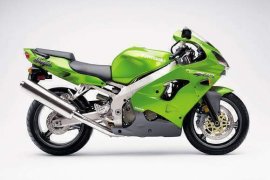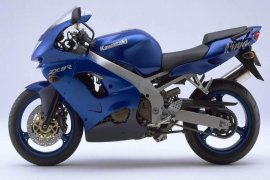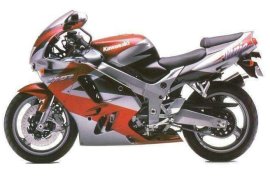KAWASAKI Ninja ZX-9R Models/Series Timeline, Specifications & Photos
First production year: 1994
The Kawasaki ZX-9R Ninja was a sports motorcycle part of the Ninja sports bike series in Kawasaki's range. The bike was manufactured from 1994, when it replaced the Kawasaki GPZ900R, until 2003 when it was replaced by the Ninja ZX-10R.
In 2000, the Japanese motorcycle manufacturer launched the Kawasaki ZX-9R Ninja, a sports motorcycle that received aesthetic modifications, improving its looks and handling improvements.
The bike's new look was improved with distinctive twin headlights and a separate ram air intake. In addition, the bike's engine received a little more horsepower due to shorter carburetors, an increased compression ratio, and larger diameter header pipes.
The bike's frame was made stiffer by enlarging the front engine mounting bolts, and the rubber bushings on the top rear engine mount were changed to alloy. Also, the swingarm pivot and wheel spindles were larger in diameter.
In the visual department, the bike packed standard features, such as a dual headlight system, a windscreen, a to-piece dual seat with pillion grab rails, a side-mounted exhaust system, and lightweight three-spoke aluminum wheels.
In the performance department, the 2000 Kawasaki ZX-9R Ninja had its heartbeat set by an 899cc four-stroke four-cylinder liquid-cooled engine fed by four Keihin carburetors, delivering an output power of 143 hp at 11,000 rpm and 101 Nm (75 lb-ft) torque at 9,200 rpm.
In 1998, the Japanese motorcycle manufacturer launched the Kawasaki ZX-9R Ninja, a sports machine that featured significant modifications, including an all-new engine that retained only the bore, stroke, and rpm's redline.
It also received chassis modifications, dropping the steel engine cradles and bolt-on rear subframe and packing a new unbraced rectangular-section swingarm. The bike's wheel sizes were the same but made with a new design and weighing less.
It used the same brake calipers as the previous model but with smaller and lighter discs without affecting the braking performance. Also, the rear shock was changed with a more lightweight piggyback unit.
On the front, the upside-down fork was replaced with a traditional one by Kayaba. The earlier fork was criticized by European testers for fluttering during hard driving, a flaw that was resolved with the 2002 model.
In the visual department, the bike packed standard features, such as a full fairing with a medium-sized windscreen, a two-piece dual seat with passenger grab handles, a right-side-mounted exhaust system, and lightweight three-spoke aluminum wheels.
Underneath its fuel tank, the 1998 Kawasaki ZX-9R Ninja had installed an 899cc four-stroke four-cylinder liquid-cooled engine that delivered 143 hp at 11,000 rpm and 100 Nm (74 lb-ft) torque at 9,000 rpm.
The engine was tied to a six-speed manual transmission with a cable-operated clutch instead of the hydraulic previously used, linked to the rear wheel through a final chain drive, pushing the motorcycle to 280 kph (174 mph).
The Kawasaki ZX-9R Ninja was a sports motorcycle part of the Ninja sports series in Kawasaki's range. The bike debuted in 1994, replacing the Kawasaki GPZ900R, and was manufactured until 2003, when it was replaced by the Ninja ZX-10R.
In 1996, the Japanese motorcycle manufacturer launched the Kawasaki ZX-9R Ninja, a sports motorcycle that featured several modifications in the suspension, braking, and performance departments.
For the 1996 model year, the maker increased the power output from 139 to 141 hp, the rear spring, and suspension linkage were replaced for better handling, the transmission was made stronger, replaced the four-piston front calipers with six-piston ones, and it received passenger grab rails.
In the visual department, the bike was similar to its predecessor, packing standard features, such as a full fairing, a windscreen, a two-piece dual seat with grab rails, a four-into-one exhaust system with a silencer on the right side, and three-spoke aluminum wheels.
The bike was built around a twin-spar aluminum frame with a 43 mm upside-down Kayaba fully adjustable fork on the front and a fully adjustable uni-track shock absorber on the rear, delivering excellent handling.
In the performance department, the 1996 Kawasaki ZX-9R Ninja had its soul brought to life by an 899cc four-stroke four-cylinder liquid-cooled engine that delivered an output power of 141 hp at 10,500 rpm and 94 Nm (69 lb-ft) torque at 9,000 rpm.
The Kawasaki Ninja ZX-9R was a sports motorcycle dressed in a full fairing manufactured from 1994, when it replaced the GPZ900R, until 2003, when it was replaced by the Kawasaki Ninja ZX-10R.
The first ZX-9R model had many designs shared with the ZZ-R1100 models, including the three-spoke aluminum wheels, the fully adjustable Kayaba suspension system, and the box-section swingarm.
In 1994, the Japanese motorcycle manufacturer launched the Kawasaki Ninja ZX-9R, a sports machine that packed standard features, such as a full fairing with a medium-sized windscreen, a two-piece dual seat, a single headlight unit, a four-into-one exhaust system with a silencer mounted on the right side, and lightweight three-spoke aluminum wheels.
The bike's suspension system comprised a 43 mm fully adjustable inverted Kayaba fork on the front and an adjustable uni-track shock absorber on the rear, offering excellent suspension performance and handling.
The braking power was handled by two 310 mm discs tied to four-piston calipers on the front wheel and a 210 mm disc with a single-piston caliper on the rear wheel, offering excellent stopping power.
As for the power figures, the 1994 Kawasaki ZX-9R Ninja had installed underneath its fairing an 899cc four-stroke four-cylinder liquid-cooled engine fed by four Keihin carburetors, boasting 139 hp at 10,500 rpm and 94 Nm ( 69 lb-ft) torque at 9,000 rpm.



